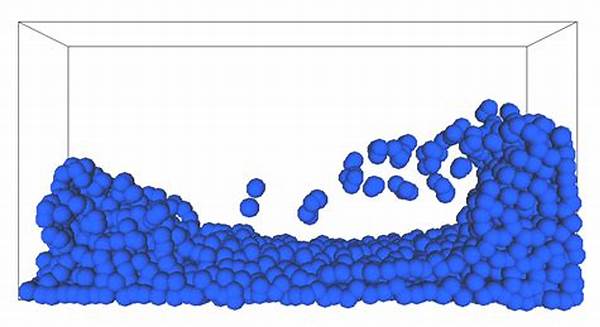Hello, dear readers! If you’re as fascinated by the mysteries of liquid movement as I am, you’re in for a treat. Today, we’re diving head-first into the captivating world of physics-based fluid simulation models. Imagine being able to simulate water flowing over rocks, or coffee swirling in your cup, all from the comfort of your computer screen. Sounds cool, right? So, grab your favorite drink, get cozy, and let’s unravel this liquid magic together.
Read Now : Tools For Creative Game Developers
What Exactly Are Physics-Based Fluid Simulation Models?
Physics-based fluid simulation models are a blend of art and science, where math meets creativity to create realistic fluid behaviors. They’re used in everything from blockbuster movies with jaw-dropping ocean scenes to everyday gaming adventures where players navigate through watery challenges. But how does it all work? These models use mathematical algorithms and physics principles to imitate how real-life fluids behave. They consider aspects like velocity, pressure, and dynamics to simulate movements that are as close to real as possible. So, whether you’re watching a tsunami on the big screen or marveling at the ripples in a tech demo, you’re witnessing the power of these incredible simulations. It’s like having a secret peek into the lab where computers learn to ‘think’ like water!
Exploring the Inner Workings
1. Realism Through Equations: The magic lies in solving the Navier-Stokes equations, which are the backbone of many physics-based fluid simulation models. They help define how fluids move in realistic ways.
2. Diverse Applications: Beyond movies, these models are crucial in engineering and environmental studies. Whether it’s predicting natural disasters or designing hydraulic systems, they’re an unseen hero.
3. From Research to Play: Game developers leverage physics-based fluid simulation models to create immersive experiences with water, lava, and even magical potions.
4. Challenges in Complexity: Despite their power, physics-based fluid simulation models can be computationally intense, requiring powerful hardware to run smoothly.
5. A Tool for Creativity: Artists and developers use these models to unleash imagination. The realistic fluid dynamics create stunning visuals that captivate audiences.
The Evolution of Fluid Simulations
Physics-based fluid simulation models have come a long way from their humble beginnings. Back in the day, creating realistic water effects required significant computing power and time. However, with advancements in technology, these models have become more accessible and efficient. Developers, scientists, and artists are now able to create complex simulations without needing massive supercomputers. This democratization of technology has opened doors to endless creative possibilities. From indie game developers to academic researchers, everyone can partake in the fun.
Interestingly, the use of physics-based fluid simulation models is not just limited to digital applications. Architects use them to visualize water features in buildings, and environmentalists employ them to study the impacts of floods. This multidisciplinary nature emphasizes just how integral these models have become in both creative and practical fields. So, next time you admire a virtual waterfall or a digitally-rendered ocean, remember there’s a rich history of innovation and artistry behind those shimmering waves.
Read Now : Best Practices For Unreal Engine Optimization
Dynamic Visuals With Physics-Based Fluid Simulation Models
Why We Love Physics-Based Fluid Simulation Models
There’s something truly mesmerizing about watching water move. It’s a universal fascination. With physics-based fluid simulation models, what was once a challenging task to represent is now an exciting landscape to explore. Filmmakers use them to tell stories where the ocean becomes a character, playing a crucial role in the narrative. The attention to detail in fluid simulations can leave audiences in awe as they watch a droplet glisten or a river rush.
Moreover, these models inspire creativity in educational settings too. Imagine a science class where students can interact with digitally simulated rivers or study the behavior of fluids under various conditions. It makes learning hands-on and incredibly engaging. There’s no substitute for experiencing that “aha!” moment when a complex physics concept is visualized so vividly. This is the core of why we love these models; they bring abstract concepts to life and make them relatable.
A Closer Look at the Development Process
Creating these astonishingly realistic effects isn’t as simple as it might appear. Developers work meticulously, often collaborating with scientists who specialize in fluid dynamics to ensure accuracy. By inputting variables like temperature, pressure, and even environmental factors, they can recreate everything from calm lakes to turbulent storms. This technical prowess is matched by a creative flair, as artists work to ensure the visual results are stunning and enjoyable for the audience.
With each new iteration, physic-based fluid simulation models become more sophisticated. Enhancements in algorithms allow for more layers of detail, such as intricate wave patterns or the glistening transparency of water. Furthermore, the push for real-time simulations lets these models be used interactively in virtual reality settings, blurring the line between digital and real-life experiences. The prospect of exploring these lifelike simulations in immersive environments is exciting and shows just how far technology in this field has come.
Conclusion: The Future of Fluid Simulations
In conclusion, physics-based fluid simulation models have transformed the way we interact with digital fluid dynamics. They’re creating new realms in storytelling, game design, and scientific research. These models have gone beyond being mere tools; they’ve become a creative partner that helps us tell stories and solve problems. From crafting breathtaking visuals in Hollywood to assisting in groundbreaking scientific experiments, these simulations provide a bridge between the virtual and physical worlds.
As technology continues to advance, we can only imagine the heights these models will reach. Perhaps one day, we’ll interact with digital fluids in ways we’ve only dreamt of—on our devices, in VR, and beyond. So, next time you click on a video game or watch a movie featuring realistic water scenes, spare a moment to appreciate the physics-based fluid simulation models working behind the scenes. They’re shaping the way we perceive and engage with the digital world.





